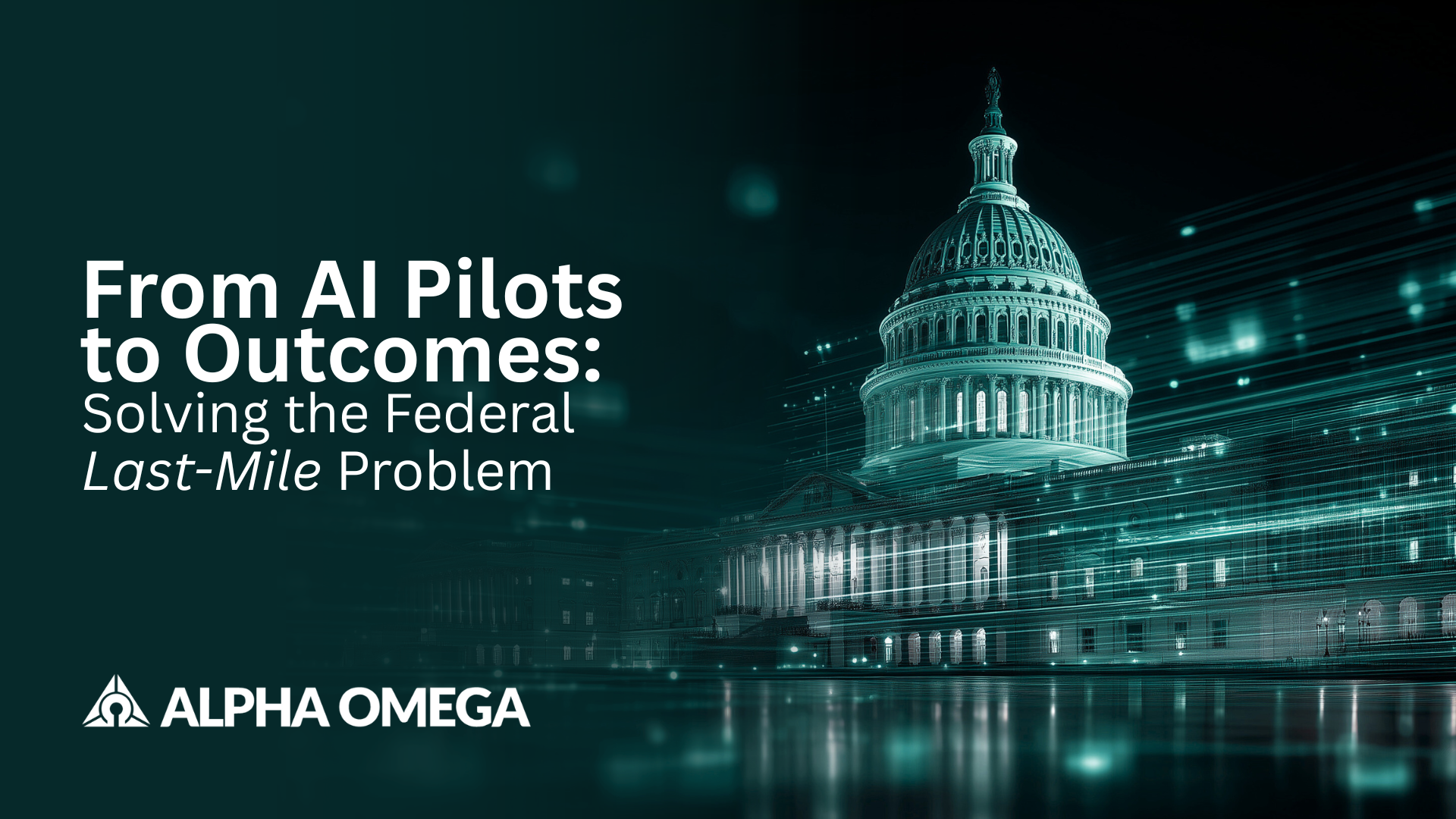Blog
From AI Pilots to Outcomes: Solving the Federal “Last-Mile” Problem
Author: Todd Hager, Vice President of Health at Alpha Omega

September 26, 2025
Adapted from Todd’s original GovLoop article: From AI Pilots to Outcomes: Crossing the Federal Last Mile
Federal agencies don’t have a model problem—they have a last-mile problem.
Promising pilots often stall before they can deliver real mission outcomes. But there is a clear way forward: moving one strong AI pilot into production without sacrificing safety, quality, or compliance.
At Alpha Omega, we’ve seen this challenge firsthand. As a trusted federal partner driving digital modernization, cybersecurity, and data solutions across organizations like the U.S. Air Force, the Centers for Disease Control and Prevention (CDC), the Defense Health Agency (DHA), and USDA, we know the barriers aren’t just technical—they’re organizational, legal, and operational. And in federal health especially, where decisions directly impact people’s well-being, bridging the last mile is mission critical.
Setting the Scene
Your agency just wrapped a successful generative AI pilot. It summarizes long case files into crisp briefings that help analysts work faster. Usability tests are positive. Privacy risks look manageable. Leadership wants results before the next budget review.
And then—progress stalls.
- Privacy requests training data provenance.
- Security wants logs, red-team results, and a rollback plan.
- Procurement asks about vendor exit strategies and portability of embeddings/prompts.
- HR raises concerns about training, workforce impacts, and quality assurance.
- The CIO demands clarity on ownership, uptime, and scalability.
Two months later, your program champion rotates out, and the backlog you meant to attack is bigger than before.
The problem wasn’t the model. It was the last mile: policy, data, people, and operations pulling in different directions without a structured path forward.
Why Pilots Stall
Three recurring patterns block federal AI projects from scaling:
- Wrong Metrics – Pilots succeed on accuracy and demos, but production lives or dies on mission KPIs (e.g., time to decision, error rates, workload balancing, accessibility).
- Unclear Ownership – If no one clearly owns outcomes, budget, and risk, the system defaults to “no.”
- Governance as an End-State – Agencies treat approvals as walls to climb, not checkpoints with preparable evidence.
These challenges typically manifest in four failure modes:
- Policy/Legal: Unclear authority, privacy gaps, outdated procurement terms.
- Data/Access: Poor lineage, consent, retention, and quality controls.
- People/Change: Training, labor engagement, and appeal paths not designed.
- Ops/Run: Logging, monitoring, red-teaming, kill switches, and service levels undefined.
At Alpha Omega, we address these with a guided, structured handoff—ensuring each stakeholder gets what they need, in order, to reduce risk and keep momentum.
The Four Gates to Production
Think of the last mile as four gates. You don’t need perfection—just sufficient evidence at each stage.
Gate 1: Policy & Legal
- Owners: Program + General Counsel + Privacy
- Deliverables: Use-case charter, data rights statement, draft clauses, Privacy Impact Assessment
Gate 2: Data & Access
- Owners: Data Officer + Security + Program Data Steward
- Deliverables: Data flow diagrams, inventories, access matrix, retention schedule
Gate 3: People & Change
- Owners: Program Lead + HR + Training/Workforce Engagement
- Deliverables: SOPs, QC plans, human-in-the-loop design, Section 508 compliance
Gate 4: Ops & Run
- Owners: CIO/Platform + Product Owner
- Deliverables: Runbooks, monitoring dashboards, red-team results, rollback plan
A 90-Day Transition Plan
Weeks 0–2: Commit
- Name a Product Owner and Platform Anchor
- Freeze the narrowest viable use case
- Select three mission KPIs
- Schedule gate reviews
Weeks 3–6: Prove the Paper
- Draft decision memos and model cards
- Document lineage and minimization
- Write SOPs and QC plans
- Negotiate procurement addenda
Weeks 7–10: Prove the Path
- Build sandbox→staging→prod environments
- Run red-team tests
- Conduct Section 508 checks
- Pilot training with 10 users
Weeks 11–13: Decide and Deploy
- Hold KPI readout vs. baseline
- If green/amber, scale to limited production
- Publish one-pager on purpose, safeguards, contacts
Case Examples
- Human Services: Pilot summarizer cut reading time by 35% but stalled over privacy and labor concerns. With minimized data, appeal paths, and clear KPIs, the team achieved a 28% time reduction to first review—without increasing appeals.
- Grants Office: AI flagging system faced ATO resistance. By ensuring explainability, exportable logs, and drift monitoring, the program entered limited production with +22% precision on top-tier flags.
Checklist / Takeaways
- Start with one narrow pilot and define “assist vs. decide.”
- Appoint a Product Owner and Platform Partner.
- Write a two-page decision memo with use case, data rights, risks, and KPIs.
- Define logging, audit, and rollback plans before ATO.
- Tie SLOs to mission KPIs, not just model metrics.
Why Alpha Omega
Alpha Omega has been on the front lines of helping federal agencies bridge this last mile. From supporting mission-critical cybersecurity at DHS, to driving data modernization for CDC, to enabling AI/ML-powered decision support across civilian and defense programs, we know what it takes to move beyond pilots.
In federal health specifically, the stakes are even higher. Agencies like CDC and DHA need AI solutions that accelerate insight while protecting privacy, ensuring compliance, and maintaining public trust. The last mile isn’t just about getting technology into production—it’s about safeguarding lives, reducing risk, and improving outcomes at scale.







